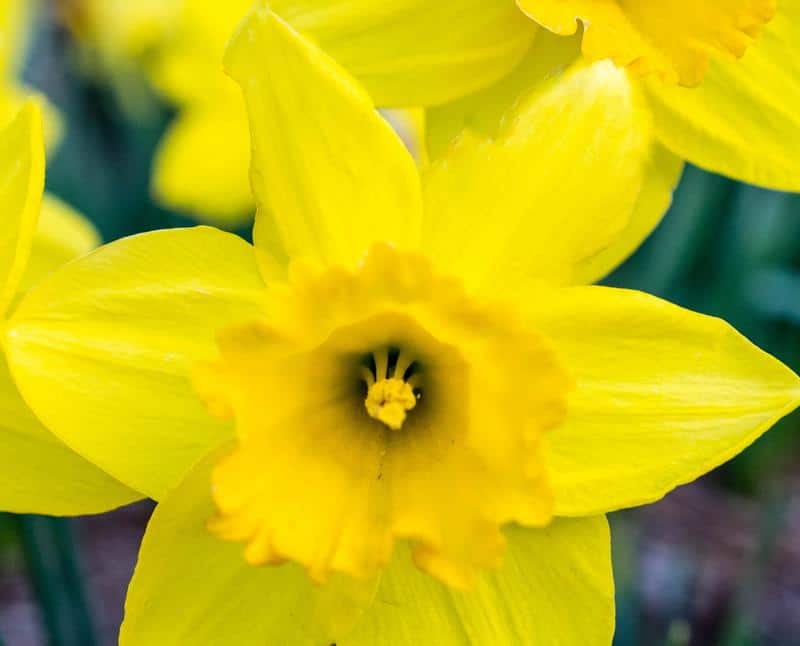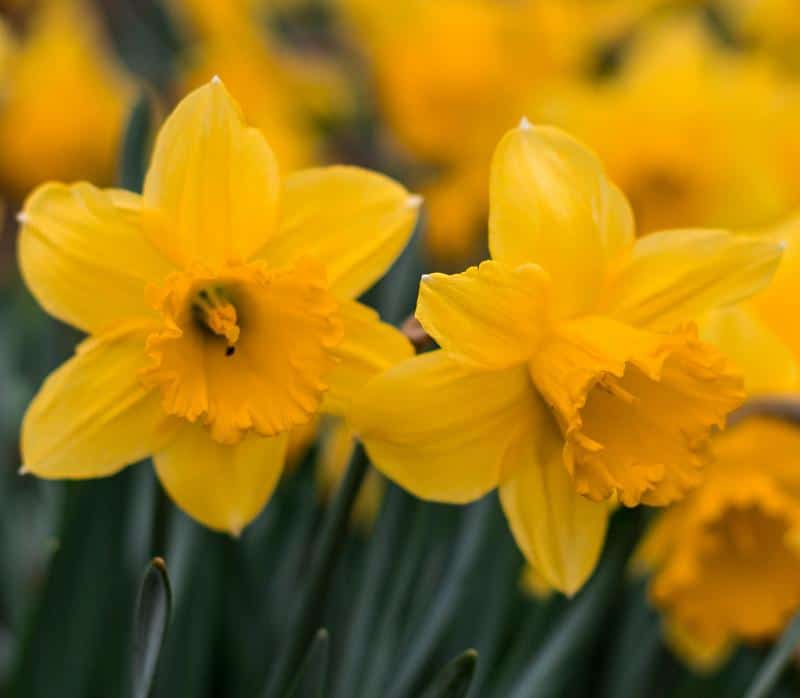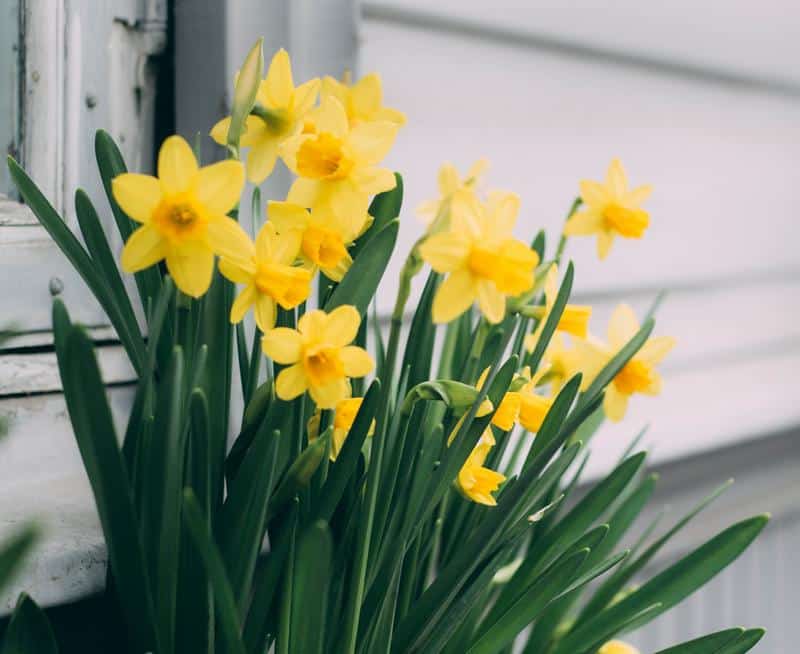Are Daffodils Toxic to Dogs? Are Daffodils Poisonous to Dogs?
Are daffodils toxic to dogs? Are daffodils poisonous to dogs? In this article, we’ll fill you in on everything you need to know about if daffodils are toxic to dogs, including what to do if they’ve already eaten some. We’re then going to teach you the two commands that will make sure that your dog stays safe around daffodils in the future.
Next, we’ll cover other important things you need to know about daffodils and dogs, such as how to keep dogs away from daffodils so they can grow to be gorgeous. Finally, we’ll close by instructing you on how to plant, grow, and care for daffodils in a home with dogs. Keep reading!
Are Daffodils Toxic to Dogs?

Daffodils are toxic to dogs. All parts of the plant, particularly the bulb, can cause serious harm to dogs if ingested. If a dog eats a daffodil, it could lead to a range of symptoms like vomiting, diarrhea, and even cardiac abnormalities. Always supervise dogs around these flowers and ensure they don’t eat them.
Are Daffodils Poisonous to Dogs?
Daffodils are poisonous to dogs. They contain a toxic substance called lycorine, which induces vomiting. Additionally, they contain other harmful alkaloids. These substances are present throughout the plant but are concentrated in the bulb.
Signs of daffodil poisoning can include drooling, nausea, vomiting, and diarrhea. More severe symptoms could include low blood pressure, tremors, and cardiac arrhythmias.
Train “Leave It” Command
Training your dog to obey the “leave it” command can stop them from eating daffodils or other toxic plants. Here’s how you can do it:
- Start by holding a treat in both hands.
- Open one hand and say “leave it”.
- Once your dog moves away from your open hand and looks at you, reward them with the treat from your other hand. This helps them associate the command with the act of moving away from something, like a daffodil.
- Repeat this exercise regularly until your dog reliably turns away from the treat on command.
Train the “Drop It” Command
The “drop it” command is another important tool to ensure your dog’s safety, especially if they manage to pick up a daffodil or any other harmful object. Here’s a simple way to train it:
- Start by playing a game of tug with a toy. Once your dog is engaged, say “drop it”.
- Stop playing and offer a treat or a different toy.
- When your dog drops the toy, praise them and provide the treat or other toy. This helps them associate dropping something they have in their mouth with a positive outcome.
- Repeat this process until your dog starts dropping the toy on command.
Daffodils are toxic to dogs, so pet owners should be very careful during the spring season when these flowers bloom. Making sure to train them on these commands will go a long way towards ensuring their safety around these and other plants.
You must remember, though, that the underlying behavioral issues (curiosity, anxiety, boredom, etc.) that were causing all of this to begin with will still be present. And until you address those, any positive changes you see are only going to be temporary.
“Well, how do I make these changes last?”
By getting your dog to truly choose to follow your direction, that’s how. I tried many times to write out how you can do that before deciding it made more sense to just link you to the free video series that explains it better than I’d ever be able to.
The series is by a man named Dan who is one of the world’s leading dog obedience trainers. In it, he teaches you how to put an end to things like your dog eating daffodils and all other misbehavior using his fast and easy-to-follow methods.
In the first video, Dan will reveal to you why the two most common methods of dog training only doom you to failure. You can watch the video now by clicking here. Follow the proven system he’ll show you in his series and you’ll never have to spend another second worrying about your dog eating a daffodil ever again!
What to Do if Your Dog Eats Daffodils

If your dog eats daffodils, contact your vet immediately. Daffodils are toxic to dogs and can cause symptoms ranging from vomiting to heart problems. The severity of the reaction often depends on the amount consumed and the size of the dog.
My Dog Ate a Daffodil
If your dog ate a daffodil, it’s important to act quickly. Daffodils contain lycorine, a substance that causes vomiting, and other toxic alkaloids that can harm your pet. Immediately after ingestion, symptoms such as drooling, vomiting, and diarrhea may appear.
More serious effects include abdominal pain, breathing difficulties, heart rhythm abnormalities, and even seizures. Seek immediate veterinary help. Do not attempt to induce vomiting without the advice of a professional.
Dog Ate Daffodil Bulb
The bulb of the daffodil is particularly dangerous because it contains the highest concentration of toxins. If your dog ate a daffodil bulb, it’s even more critical to get to the vet as soon as possible. In addition to the symptoms mentioned above, your dog may also experience an increased heart rate and changes in blood pressure.
Your vet may induce vomiting, provide activated charcoal to bind the toxins, or even admit your dog for supportive care depending on the severity of the situation.
Dog Eating Daffodils: Preventative Measures
Preventing your dog from eating daffodils in the first place is the best course of action. Monitor your dog while they are in the garden, especially during the spring season when daffodils are in bloom. Training commands like “leave it” and “drop it” can be particularly effective in these situations. Learn both in the first section.
If you spot daffodils growing in areas your dog has access to, consider removing them or fencing off the area.
In conclusion, if your dog eats a daffodil, it’s very important to act swiftly and consult with a vet immediately. Ingesting daffodils can lead to serious health issues in dogs. Always supervise your pet around these flowers and train them with the right commands to prevent them from eating harmful plants.
Make sure to get this problem corrected right away because it will help make sure that your dog keeps safe around plants in the future. You then won’t have to think about things like are petunias safe for dogs, is Ruellia poisonous to dogs, are zinnias poisonous to dogs, or are begonias poisonous to dogs.
Daffodils and Dogs

Daffodils are beautiful, bright flowers that are common in many gardens, especially during the spring season. However, daffodils are toxic to dogs if eaten, causing symptoms like vomiting, diarrhea, and even cardiac abnormalities. Therefore, it’s crucial for dog owners to know how to keep their furry friends safe around these plants.
How to Keep Dogs Away From Daffodils
Keeping dogs away from daffodils starts with a high understanding of your dog’s environment. Fence off areas of your garden where daffodils are growing to prevent access. Alternatively, you could choose to plant your daffodils in areas that are out of your dog’s reach.
Remember to properly dispose of cut daffodils, as they can still be a hazard if your dog finds them. Training your dog to obey commands like “leave it” and “drop it” can also be very beneficial. Learn how to do both in the first section.
Daffodil Poisoning in Dogs Symptoms
It’s important to know the symptoms of daffodil poisoning in dogs. These include drooling, vomiting, diarrhea, abdominal pain, and increased heart rate. If you notice any of these symptoms in your dog after they have been around daffodils, seek immediate veterinary attention.
Immediate Steps After Ingestion
If you suspect your dog has eaten a daffodil, contact your veterinarian immediately. They may advise you to induce vomiting at home or bring your pet in for treatment, depending on the situation. Immediate professional help is crucial in these scenarios.
To wrap up, while daffodils are attractive flowers, they pose a significant risk to dogs if eaten. You should do your best to control your dog’s access to areas around these plants and be aware of the signs of daffodil poisoning. Learn the commands that will prevent future problems in the first section.
How to Plant, Grow, and Care for Daffodils

Planting, growing, and caring for daffodils involves selecting a sunny location, preparing the soil with good drainage, planting the bulbs in autumn, watering moderately, feeding with bulb fertilizer, and allowing the foliage to die back naturally after blooming.
Daffodils are a favorite spring-flowering bulb, valued for their reliability, ease of growth, and striking yellow or white flowers.
- Selecting a Location: Choose a location with full sun or partial shade. Daffodils can tolerate a variety of soils, but a well-draining location is essential to prevent bulb rot.
- Soil Preparation: The soil should be rich and well-draining. If needed, improve heavy soils by incorporating plenty of organic matter or compost before planting.
- Planting Bulbs: Plant daffodil bulbs in the autumn, typically in September or October. The bulbs should be planted at a depth of about three times their height, with the pointed end facing upwards. Space bulbs about 3-6 inches apart.
- Watering and Feeding: Water thoroughly after planting and continue to water regularly, particularly during dry spells. Feed daffodils with a high-potassium bulb fertilizer in early spring, just before they start to bloom.
- Post-Flowering Care: After the daffodils have bloomed, let the foliage die back naturally. This process allows the plant to store energy for next year’s bloom. Resist the urge to mow or cut back the leaves until they have yellowed and withered.
Learn how to keep your dog away from daffodils by going back to the first section.
By following these steps, you can enjoy the vibrant blooms of daffodils each spring. These resilient and low-maintenance flowers can enhance any garden with their bright colors and classic shape, signaling the arrival of the new growing season.
I’m sure you’re looking forward to not worrying about this issue with daffodils and dogs anymore, so I’ll let you get started now. Good luck with all of this, and thanks for reading our article “Are Daffodils Toxic to Dogs? Are Daffodils Poisonous to Dogs?”





